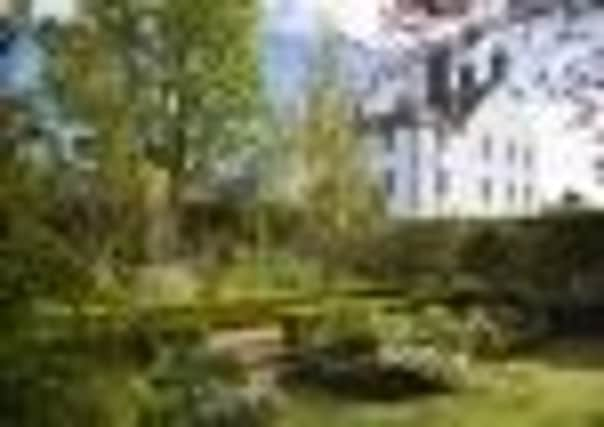Gardens: The garden at Gallery, in Angus that doesn’t hedge its bets


Both explain that the garden is recovering from the effects of two long, cold winters and there has been much damage, to the roses in particular.
They need not have worried. For visitors to Gallery, the 17th-century house that’s a short walk from the River North Esk and has views over the Howe of Mearns, neither the weather nor a perceived shortage of roses detract from the beauty of this garden. The grounds are so well landscaped and the walled garden so cleverly laid out and planted with such flair and attention to detail that it triumphs over the worst conditions and shines like a jewel when the sun appears.
Advertisement
Hide AdAdvertisement
Hide AdThe scene is set at the foot of the entrance, where the drive sweeps between immaculate lawns planted with scattered groups of fresh, young trees. At the front door, a pair of diamond-shaped beds planted with box pyramids are set off against beds of annuals, and purple and white pansies in spring.


To the right is the walled garden, where a row of young birch trees are underplanted with rich-purple tulips. This part of the garden and the landscape north of the house, John explains, was recently reshaped by landscape designer Laura Mackenzie.
The recent history of the walled garden is intriguing. When John and his late wife Anne bought Gallery, in 1995, the acre-and-a-half walled garden was neglected and overgrown. Despite having almost no gardening experience, Anne was determined to restore it, which she did with the help of designer Veronica Adams. Together they worked out a plan inspired by the garden at Crathes, in Aberdeenshire.
A year later, skilled gardener Ron arrived, and since Anne’s death, seven years ago, he has continued developing the layout of distinct, semi-symmetrical spaces derived from the central path, or axis. Each space, or room, is enclosed with yew and privet hedges and punctuated with distinct box shapes. Height comes from evergreen trees and deciduous varieties such as acer, prunus and malus. It is this structure that ensures year-round interest while looking good in all weathers.
Glimpsed through a metal claire-voyée, the walled garden is entered through a white iron gate that opens up into a circular paved area, furnished with a tall urn and backed by a yew hedge. A pair of standard laurels flank the entrance to the main path. So intense is the structure that your first impression is of entering a maze: three paths entice in different directions.
Turning left on to the perimeter path ,you walk through a blue and yellow border, enhanced in spring with Tulipa ‘French Elegance’, one of more than 1,000 tulips that mingle with the fresh foliage of young herbaceous plants. “We treat the tulips like annuals here,” Ron explains, “planting and trying new varieties every year.” The yellow or golden theme continues in the next space, the Gold Garden, where the underlying structure of golden conifers and variegated holly acts as a backdrop to curved beds.
Further along, the Summer Garden is an informal space where curved and island beds are planted with shrubs, roses and perennials, chosen for the red and pink tones of their flowers and foliage. In spring, colour comes from groups of red tulips.
At the foot of the garden, the Dog Gate leads past newly planted beds of heathers punctuated with azaleas, towards the recently developed river walks that lead past fields of newborn lambs towards the river.
Advertisement
Hide AdAdvertisement
Hide AdTucked away at the side of the garden wall is a compact greenhouse, where Ron skilfully juggles a range of young plants and seedlings, some destined for the nearby vegetable garden.
Widely regarded as the heart of the garden, the Pool Garden features a backdrop of white trellises centred on a stone fountain. Here, in spring, you find small drifts of creamy tulips – the double ‘Mount Tacoma’ and ‘Datona’ stand out – and iris among standard Rosa ‘Ice Berg’, emerging Dicentra alba, peonies and fox tail lilies. In summer these are followed by Crambe cordifolia and white delphiniums, while the air is packed with the fragrance of lilies.
The central path has proved a useful, sheltered space, to experiment with tender varieties such as yellow-flowering Piptanthus napaulensis. Suffering damage after two cold winters, this plant was cut back and is now rejuvenating. “I like to leave a plant that looks dead for at least a year before removing it, to give it a chance,” Ron says.
But perhaps the most striking vista is lined with parallel rows of hydrangea punctuated by saddle stones: so tender are the hydrangeas that every winter Ron cocoons each one in a frame covered with sack-cloth.
As its name suggests, the Old Rose Garden is packed with varieties of climbing, shrub and damask roses, including deep pink ‘Empress Josephine’, pale pink ‘Fantin Latour’ and ‘Celestial’, vigorous ‘Cerise Bouquet’ and the white scented damask ‘Madame Hardy’. ‘Rambling Rector’ and ‘Wedding Day’ have proved reliable at smothering walls and supports; in spring the young rose foliage adds another dimension.
The last two spaces include a sitting area furnished with a bench, and a tiny shade garden. Here, as elsewhere in the garden, Ron rebuilt the low dry-stone walls that enclose the beds.
Ron says he enjoys the garden early in the season, when “you just see the bare bones and catch glimpses of different rooms through gaps in the hedges”. He says, “Even after 13 years at Gallery I can’t wait to get up in the morning to see what each day will bring.”
Gallery, Montrose, is open under Scotland’s Gardens on Sunday 3 June and Sunday 8 July, 2pm to 5pm. Partial disabled access ([email protected]; www.scotlandsgardens.org)